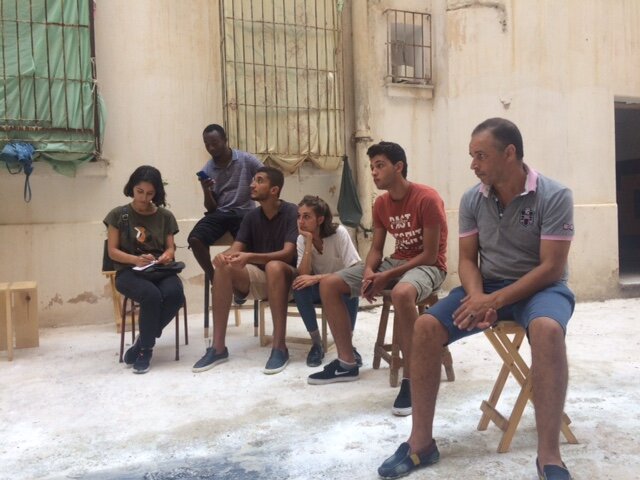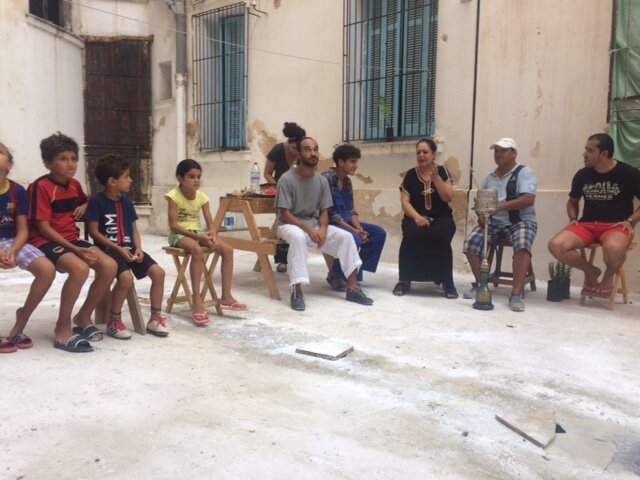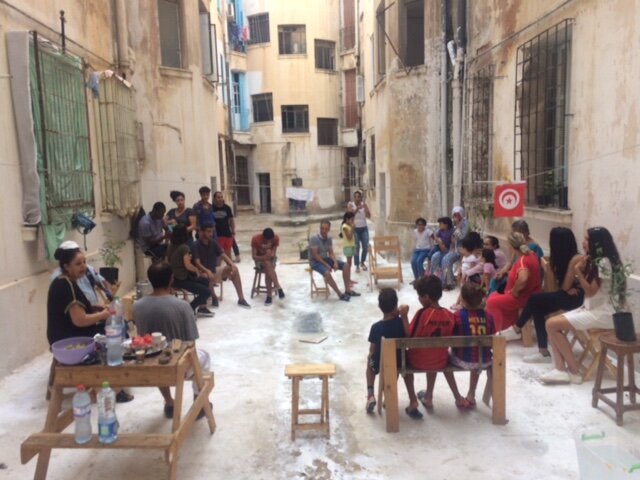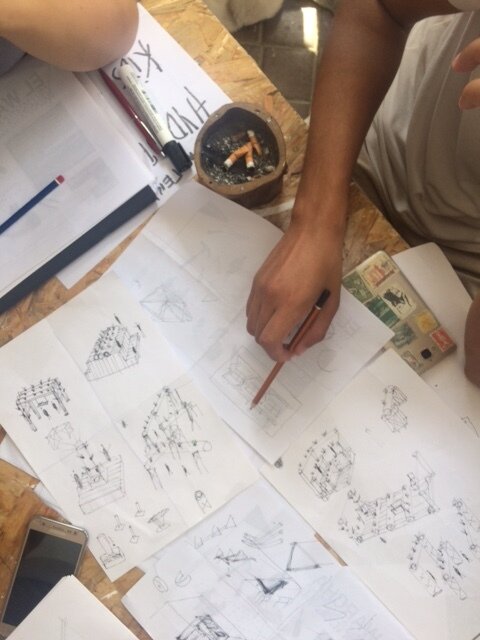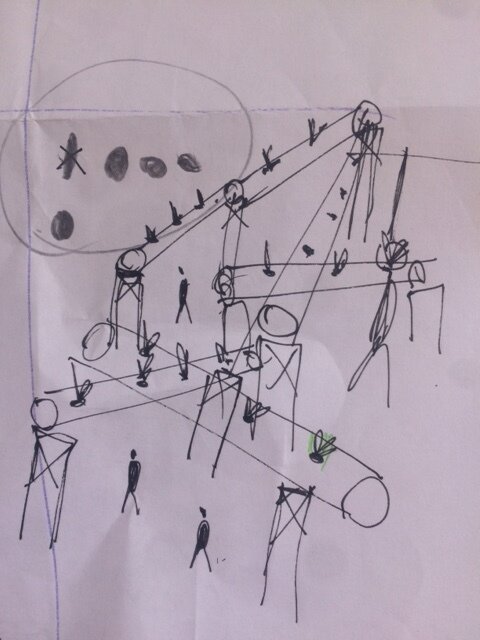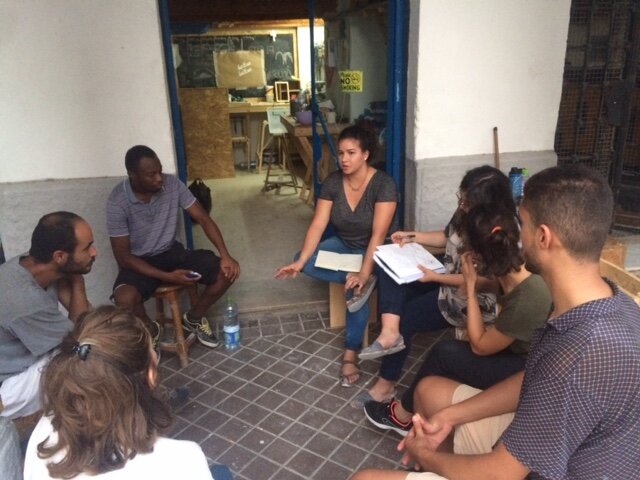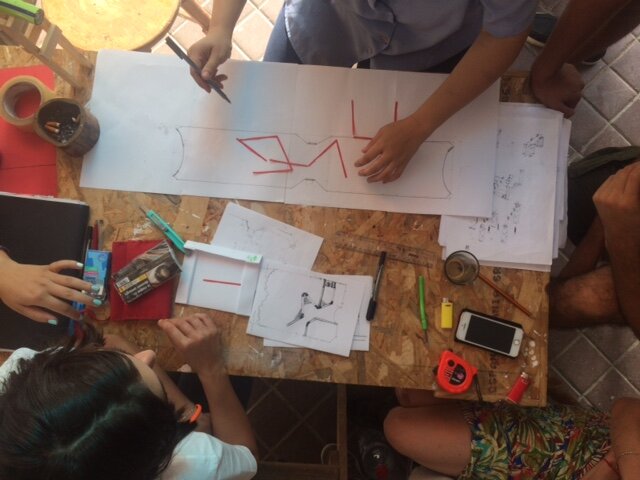Hydroponic Garden
About thirty people came to the meeting and shared with us their desires and findings about this common space.
During the week of 15 to 22 September 2019, the El Warcha London team, composed of Benjamin Perrot and Inês Marques, came to El Warcha Tunis for a residency. Inês Marques, a trained designer specialising in water issues, proposed to develop a hydroponic project that would benefit the community of the Hafsia district, where El Warcha Tunis is located. The Tunis team prepared the groundwork upstream in order to initiate a dialogue with the inhabitants, but also to find the location of this hydroponic project. For several months now, the members of Warcha Tunis have been approached by the inhabitants of the building in which the workshop is located, in order to carry out a project in their courtyard. It therefore seemed interesting to us to offer them the hydroponic system in this space, which would be developed and co-realized with the living community.
To do this, we organized a meeting on Sunday, September 15, 2019 in the courtyard of the building with the help of Ridha, a resident who has lived there all his life. Ridha helped us a lot during all the stages of the project and acted as a mediator between the members of El Warcha and the residents of the building. About thirty people came to the meeting and shared with us their desires and findings about this common space. Many of them were sorry about the current state of the courtyard, which often becomes a heap of rubbish. However, some of the residents meet regularly to discuss the issues.
In order to clean this space. This was the case for this meeting: we cleaned the yard with a few neighbors so that we could put tables and chairs there. When the subject of the future of the courtyard came up, many residents insisted on their desire to create a space for children to play in safety, but also on their willingness to plant the area: we were therefore able to submit the idea of a hydroponic system, which would benefit everyone, but which would remain intended for the living community only.
This meeting being a first moment of exchange and official dialogue with our neighbours, we were able the very next day to discuss the idea and conceptualisation of this hydroponic system. In order to meet the expectations of the inhabitants, we decided to think of this installation as a playful element, so that it could be a means of making the courtyard greener, but also so that it could be attractive and pleasant for children. After discussing several ideas, we decided to focus on a hydroponic system that would take the form of a course, playing on the heights, and would allow a whole new understanding of the space of the courtyard by giving it a playful dimension. During this day of ideas, we also made a prototype of the hydroponic system, both to test the water pumps that Benjamin Perrot and Inês Marques had brought back from London, but also to make the system more explicit and understandable. This first step of concretisation allowed to arouse the curiosity of some passers-by and also of other neighbours who were not present at the meeting.
Then, after a few hours of reflection on the form that the course could take, we agreed on the structures that would carry the PVC pipes, the elements in which the water could circulate and irrigate the plantations. Given the size of the pipes (4m long), we have built quite monumental wooden elements (up to 3m high for the largest), which will allow us to structure the installation correctly, but also to work on the scale of the courtyard, whose dimensions are important.
All the construction work was done in collaboration with the inhabitants of the building, and especially with young people and children, who immediately appreciated the idea of the project. After the wooden structures were built, we prepared the PVC tubes to accommodate the plants: we drilled the tubes several times, taking the size of the water bottles, which we collected with the help of the residents throughout the week,
and which, once filled with soil, would serve as pots for the plants we wish to plant. The choice of plants, after discussion with the inhabitants, was directed towards herbs whose functional aspect - especially in the kitchen - allows daily interaction.
We potted the plants with the children of the building and the neighbourhood, who greatly appreciated the fact of touching the earth, but also of making their common space greener. Finally, we installed the entire hydroponic system on Saturday, September 21. The residents present were delighted to see it installed, and even invited neighbours from other buildings to come and see the installation. On the same day, we also installed a large series of flags silk-screened by Aisha Abbassy, currently in residence at El Warcha Tunis. Throughout the week, Aisha developed silk-screen typogra- phies with the names of the herbs we planted and motifs that reflect the architectural codes of the building and the Hafsia district, in collaboration with local residents. This series of flags makes the space of the courtyard all the more warm and welcoming, and resonates with the installation of the hydroponic system.
At present, many visitors from other buildings continue to visit the courtyard and are asking for a similar installation in their common space. Ridha has become the "hydroponic guide" of the neighbourhood, who will take visitors on a tour of the area and explain the irrigation system to those interested. This installation of a hydroponic system has undoubtedly had a strong impact not only on the scale of the building but also on the neighborhood, and has enabled the El Warcha Tunis team to deepen a dialogue and exchanges with the community living in Hafsia.
After the departure of the London team, the members of El Warcha Tunis agreed to continue to intervene in this courtyard and to make the best use of it, in particular by developing seating and other games for children, at the request of the building's residents. An adventure that has only just begun and that promises even more links and exchanges with the Hafsia district!
WHAT HAPPENED SINCE ?
Students from the INAT Junior Enterprise accompanied us from the end of November 2019 in an expertise of the hydroponic system created last September. It turns out that this system was hybrid and not 100% hydroponic: we had grounded it, but this is not necessary in a hydroponic system and above all there is a high risk of damaging the pump. Until their expertise, the plants installed in the system were doing quite well (in our opinion, but we are not experts). Some leaves of some plants were yellowish and showed a lack of nutrients. Also, the PVC pipes were found to have slopes that were too steep. The water was therefore not sufficient to irrigate the plants in the system as well as possible.
the finding that the installed system, consisting of 2 pumps, in fact had only a really efficient hydroponic system (the one on the left as you enter the yard) and that the right part was not hydroponic at all because
these students have proposed two solutions:
completely remove the soil in the pots installed in the system and adapt the choice of plants to hydroponics. It was suggested that we install leafy plants with strong roots that could more easily capture the water flowing through the tubes;
review some of the slopes of the system so as not to let the water run off too quickly, which prevents good irrigation of the plants.
---> we first reviewed the slopes of the tubes but also removed one of the two pumps: only the pump of the system on the left when entering the yard was kept. The second pump on the right will be used for the hydroponic system on the roof of Dar el Harka.
In a second step, we built wooden tubs that run along the walls of the yard before planting the plants that were present in the hydroponic system. It is a simple cultivation in tubs with soil that will be watered regularly.
At the same time, we built a second pyramid-shaped structure that also served as a support for the hydroponic system. The pyramid shape had been ordered by the students of the Junior Entreprise because it is the most favourable shape for a fast growth of the plants (question of yield). The second pump was therefore integrated into this system now installed on the roof of Dar el HArka since the end of January 2020.
For their part, the students had sowed lettuce, lamb's lettuce and spinach (sown at the end of November 2019) which we integrated into the two hydroponic systems at the end of January 2019, when they had reached the "growing" stage (courtyard and roof).
When we installed the sprouts in the system, we completely removed the soil from our pots that were integrated into the PVC tubes: they are now plastic cups, pierced several times in the bottom, and filled with clay balls that retain water. The roots of each plant pass through the holes to the outside to catch the water flowing into the tubes. At the same time, nutrient solutions are regularly added to the water basin consisting of nitrogen, phosphorus and potassium. Also, a solution that promotes root growth is added to the pond where the pump is located.





